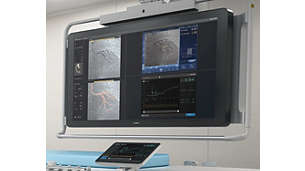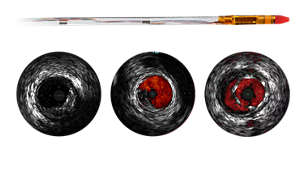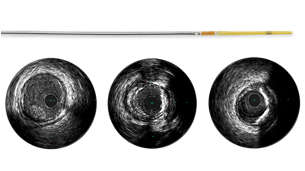The clinical evidence is clear, IVUS-guided PCI benefits patients
By Philips ∙ Oct 23, 2019 ∙ 6 min read
IVUS imaging helps you decide, guide and confirm the right interventional treatment for each patient. IVUS-guided PCI strategies are backed by a wealth of clinical studies. The ESC gives a Class I, level of evidence A recommendation when performing PCI on anatomically complex lesions, in particular left main stem, true bifurcations, and long lesions1. Explore the various studies below to learn more about the evidence that drove the ESC to give the highest level of recommendation in the guidelines.
At-a-glance

ESC Guidelines1
ESC elevates intravascular imaging to a Class IA recommendation

Plug-and-play simplicity of Philips Eagle Eye Platinum is the easiest way for physicians to get with the IVUS guidelines.
Stone Network Meta Analysis 2024²
For this systematic review and updated meta-analysis, investigators searched the publication databases from inception through August 30, 2023, for studies that randomly assigned patients undergoing PCI with drug-eluting stents to either IVUS or OCT, or both, or to angiography alone to guide their interventions. Meta analysis of 22 randomized controlled trials with nearly 16,000 patients reinforces the benefits of image-guided PCI. Imaging improves outcomes and saves lives.2
RENOVATE-COMPLEX-PCI³
Intravascular image–guided PCI with IVUS or OCT versus angiography-guided PCI in patients with complex coronary-artery lesions Intravascular image-guided PCI was associated with a lower incidence of a composite of cardiac death, target vessel-related myocardial infarction, or clinically driven target vessel revascularization compared to angiography guided PCI.3

ULTIMATE RCT 3-year outcome data
Intravascular ultrasound-guided versus angiography-guided implantation of drug-eluting stent in all-comers.⁴,⁵
“Intravascular ultrasound (IVUS)-guided drug-eluting stent (DES) implantation is associated with fewer major adverse cardiovascular events compared with angiography guidance for patients with individual lesion subset. However, the beneficial effect on major adverse cardiovascular event outcome of IVUS guidance over angiography guidance in all-comers who undergo DES implantation still remains understudied.“
Zhang J et al
Compared to angiography-guided PCI alone, in all comer patients, ULTIMATE shows that IVUS-guided PCI significantly reduces Target Vessel Failure (TVF) mainly driven by the decrease in clinically driven target vessel revascularization (TVR). This benefit was sustained over three years. Only 1.6% TVF at 12 months and 4.2% TVF at 3 years when optimal IVUS-guided PCI criteria was met. Primary endpoint based on patient-level comparison

ADAPT-DES⁶,⁷
The ADAPT-DES study reported that IVUS guidance was associated with:

AHA/ACC/SCAI Guidance
Guidance strengthens use of IVUS during stent implantation and to determine the mechanism of stent restenosis and thrombosis8


All 2B recommendations from the 2011 guidance elevated to 2A in 2021 guidelines.
Subscribe to our email updates
Footnotes
1. Vrints et al. 2024 ESC Guidelines for the management of chronic coronary syndromes. Eur Heart J. 2024 Aug 30.
2. Stone G, et al. Intravascular imaging-guided coronary drug-eluting stent implantation: an updated network meta-analysis. The Lancet, Volume 403, Issue 10429, 824 - 837
3. Lee J M, et al. Intravascular Imaging- Versus Angiography-Guided Percutaneous Coronary Intervention For Complex Coronary Artery Disease (RENOVATE). N Engl J Med. March 2023.
4. Zhang J et al. Intravascular Ultrasound Versus Angiography-Guided Drug-Eluting Stent Implantation: The ULTIMATE Trial. Journal of the American College of Cardiology (2018)
5.Outcomes of the ULTIMATE Trial Comparing Intravascular Ultrasound Versus Angiography-Guided Drug-Eluting Stent Implantation, JACC: Cardiovascular Interventions (2020), doi: https://doi.org/10.1016/j.jcin.2020.10.001.
6. Maehara A. et al. Relationship between intravascular ultrasound guidance and clinical outcomes after drug-eluting stents: the assessment of dual antiplatelet therapy with drug-eluting stents (ADAPT-DES) study. Circulation. 2014 Jan 28;129(4):463-70.
7.Witzenbichler B et al. Relationship Between Intravascular Ultrasound Guidance and Clinical Outcomes After Drug-Eluting Stents: The ADAPT-DES Study. Circulation 2014 Jan: 129,4;463-470
8.Lawton J. et al. 2021 ACC/AHA/SCAI Guideline for Coronary Artery Revascularization. JACC. 2022;79(2):e21-e129




